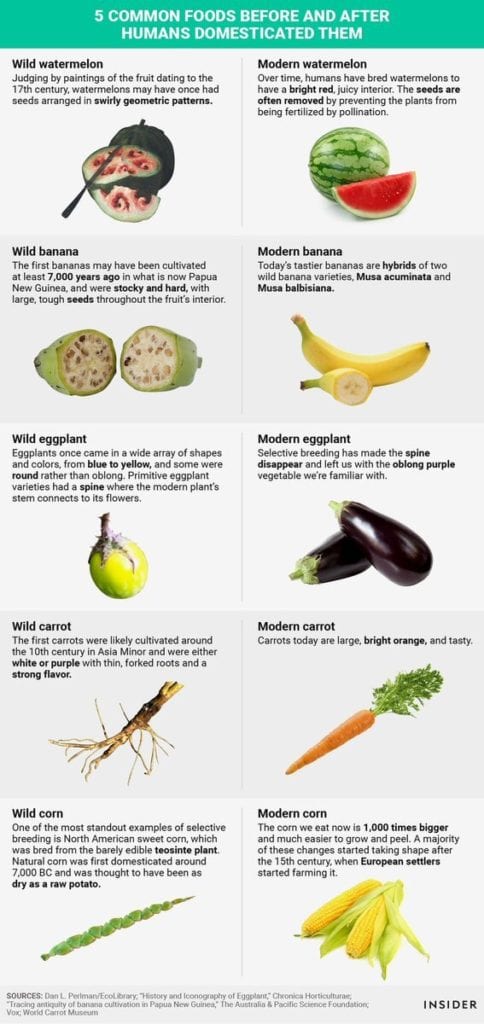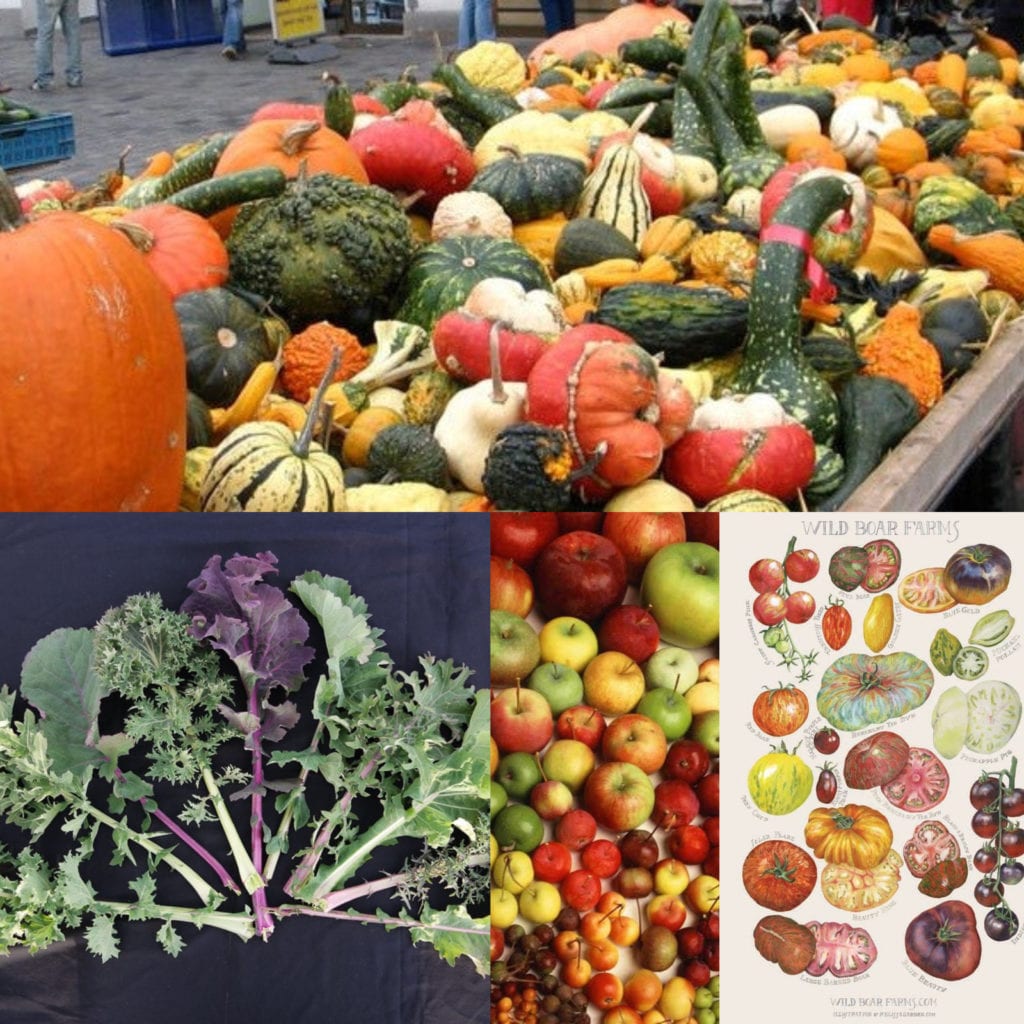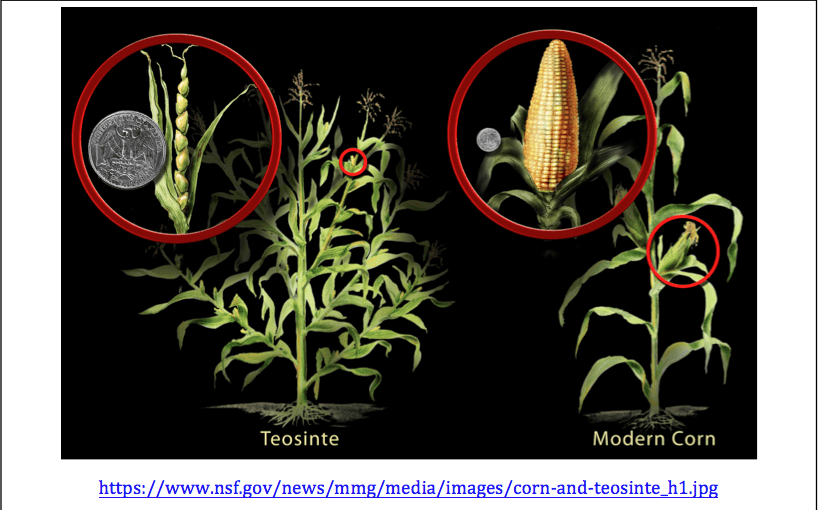Welcome to the first entry of The Approaches for Crop Improvement series: Traditional Plant Breeding! Today’s post will look at how traditional plant breeding capitalizes on naturally occurring biodiversity to create the food crops we depend on daily. The variety we see in fruits, vegetables, and grains in grocery stores and farmer’s markets has its origins in the diversity that already existed in their wild ancestors, intervention by humans over the centuries to improve them, and something called natural selection. The concept of natural selection can be summed up as “survival of the fittest”- those organisms that are better able to adapt to environmental pressures are more likely to survive, and in turn pass on these favorable characteristics to future offspring. We as a human society have capitalized off of this concept, and have used this power of selection to best meet our basic needs (think food, fiber, and fuel).
When humans select for these needs it is termed artificial selection. As opposed to waiting for nature to run its course and provide desired food crops, humans selected for those crops that exhibited desired traits. When you consider some of the popular food crops of today, and their wild ancestors that they came from, you can see that major changes occurred as the result of selection. Below are just a few examples of the phenomenon:

Image source: https://www.insider.com/fruit-vegetables-seeds-pits-domestication-2017-1
The starting points: DNA, genes, alleles, and biodiversity
How did we get from these wild crops to the ones we know today? If we look at what is going on at the molecular level we will see that these changes occurred due to changes in DNA, the genetic material that programs an organism’s attributes. Sections of DNA make up what we refer to as genes, and the collection of genes that make up an organism is referred to as a genome. Within these changes there is variance- the underlying cause of biodiversity. Variants in these genes are known as alleles. If we think of human eye color, the genes that control accumulated pigments within the eye vary from individual to individual, resulting in blue, brown, green, and hazel iris colors. These differences are caused by different alleles of eye color genes that are distributed throughout the population resulting in different physical attributes or phenotypes. Different combinations of alleles over a multitude of genes give rise to distinct individuals.
Such genetic variation that results in different characteristics is also present within plants as displayed below. All the difference in colors, shapes, and sizes are all caused by genes and their alleles that lead to a large amount of variety, or what is referred to as biodiversity. This biodiversity is like an artist’s palette for plant breeders to use to improve the crops we rely on or develop new ones to help secure our food supply. Take a look at some the biodiversity below that we see on a daily basis in our fruits and vegetables! This is all a result of what was described in the first two paragraphs related to inherent variation in wild ancestors, natural and artificial selection.

Image Sources: Top: https://www.syngentafoundation.org/biodiversity. Bottom Left: https://www.adaptiveseeds.com/product/vegetables/kale/kale-gulag-stars-organic/ Bottom Center: http://treefruit.wsu.edu/varieties-breeding/cultivar-guide/. Bottom Right: https://valeaston.typepad.com/plant_talk/2014/05/blue-is-the-new-red-come-hear-the-tomato-experts-at-molbaks-on-may-31.html
How are the starting points combined to improve crops through plant breeding?
Using the examples from above, you can see that there can be great variance in characteristics within a single species. This is a result of differences in the plant’s genes and alleles, which cause a variety of characteristics to occur. This variety creates opportunities to make improvements and enhance characteristics such as flavor, yield, pest resistance, drought tolerance, and resilience to the pressures of climate change. Traditional plant breeding benefits from these differences in characteristics caused by variation in genes and their alleles because they are a rich source plant breeders can utilize to breed for desired phenotypes.
In breeding programs, plants with desired traits are selected and used as breeding material. In each generation of breeding, the plants with the desired characteristics are chosen to be the breeding material for the next generation. A large amount of biodiversity allows breeders to have more options to choose from to create their desired results. It is important to note however that it may take many generations resulting in many years needed to create the ideal plant, and thus plant breeding can be a slow process.
An example of this progress is displayed below for maize and its wild ancestor teosinte. Teosinte is a large, sprawling, multi-branched plant with small “ears” that has a single row of kernels each covered in a hard shell. Over many centuries, indigenous Americans applied cross-pollination and artificial selection, the basis of plant breeding, on the small and practically inedible teosinte in order to achieve plants with more manageable growth, larger ears, and shell-free seeds. These are the traits that we are familiar with in the corn we eat today. As you can see, radical improvements are possible with plant breeding. These enhancements form the foundation of our food systems and were even the turning point in history, in many cases, that allowed humans to abandon nomadic lifestyles and develop stationary civilizations. However, these improvements can only be made over long time periods with traditional plant breeding, and this system of selection has several other limitations.

Challenges and limitations of traditional plant breeding
Plant breeders face challenges in their crop improvement programs such as limited availability of naturally occurring diversity for traits and the time it takes to achieve desired improvements. In the example above, it took hundreds of years to make the substantial improvements necessary to produce corn from its ancestral teosinte. This time investment is a major obstacle for rapid plant improvement and the domestication of novel crop plants. To make small enhancements to an already-improved crop (e.g. breeding modern corn to have a higher yield), a 6-12 year crop breeding program is usually required to produce a new and improved variety. This is a very long time, especially within the context of climate change and growing global populations that will require greater amounts of food and natural resources.
This large time requirement is the biggest limitation of traditional plant breeding. While the technique has succeeded in achieving the crops we have today, accelerated improvements will be necessary to meet the future demands of our growing population. To meet this challenge, plant breeders have spent decades developing novel techniques to accelerate traditional plant breeding by drawing upon our knowledge of plant genetics. As a result, breeders are now able to better predict plant phenotypes, saving time and energy in the breeding process- a necessary change to keep up with the ever-burgeoning pressures of society.
Concluding points: a powerful but slow approach
Biodiversity is the starting material that plant breeders utilize to develop improved varieties of crops. Through the process known as artificial selection, desired traits are chosen and combined to create superior crops. While this process forms the foundation of crop improvement, it is quite slow on its own and cannot keep up with the demands of today’s society.
These greater demands for rapid improvement have resulted in enhancements to the techniques used in traditional plant breeding itself, drawing upon our greater knowledge of plant genetics. In this series, we will delve into these innovations and explore how they can expand the potential of traditional plant breeding and the possibilities for crop improvement. Stay tuned for more in the coming weeks!
